The all-new DesertX is Ducati’s first production bike to run a 21-inch front wheel in the modern era, but it’s also one hell of a roadbike.
The 2022 Ducati DesertX is a welcome throwback to the early 1990s and the golden era of the infamous Paris-Dakar Rally, an event dominated by gargantuan twin-cylinder dune busters. These bikes were big, brutal, fast – and cool. And while Ducati never won the Dakar, its engines did in 1990 and 1994 with Cagiva, and the new DesertX is clearly inspired by those old-school Dakar icons.

The DesertX first appeared in concept form at EICMA 2019 as an air-cooled 1100, complete with side-mounted Scrambler-style shock. It looked awesome. The production bike today looks similarly dramatic and, thankfully, Ducati has stayed with the concept bike’s twin headlights. The powerplant is now the 937cc water-cooled 81kW (110hp) Testastretta V-twin, and the rear shock has moved to a more conventional position, but otherwise, it’s equally evocative and true to the original vision.
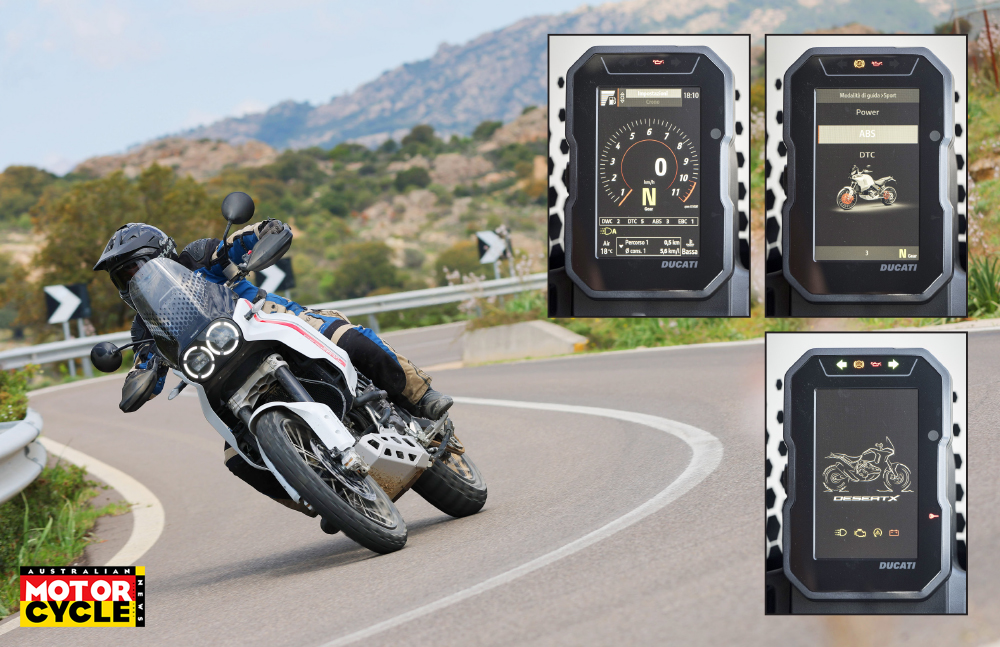
Dakar vibe of the X is reflected by the vertical mode of the TFT dash
It is also a huge step for Ducati, which is stepping into a new class. It’s the first production bike to come from Bologna with a 21-inch/18-inch front/rear wheel combination since the 1960s, and required an all-new chassis, suspension, electronics. Almost every part is unique to the DesertX, which is not something we’ve been able to say about many new Ducatis of late.
The 2022 Ducati DesertX has been designed to work both on and off the road, while being intrinsically easy to use, so it has much to prove.

RIding Modes
It’s immediately apparent that Ducati has got the fuelling and throttle response spot on again. In Touring mode the throttle delivery is easy and soft, and each gear slots home with ease, even without the clutch thanks to the (standard) two-way quickshifter. Indeed, while some manufacturers of V-twins struggle, Ducati has perfected its fuel injection.
There’s a surprising bark to the DesertX’s exhaust that sets the tone nicely for the ride ahead, although what happens next ultimately depends on the riding mode selected. There are six of them: Sport, Touring, Urban and Wet, plus two off-road modes, Enduro and Rally. Each mode tailors the power output and throttle response, with Sport and Touring making the full 81kW available (albeit with different throttle responses), while Urban and Wet cap peak power at 70kW (95hp). Enduro brings that down to 55kW (81hp), whereas Rally lifts it back to 81kW, again with each mode deploying a specific fuelling map. ABS, DTC (traction control), DWC (wheelie control) and EBC (engine brake) are all present and lean-angle sensitive.

There are distinct differences between the modes, in both power and throttle response. Most owners will initially opt for Touring, with its full power and lovely smooth throttle response. But while Sport mode is certainly livelier and more direct, Ducati has also managed to maintain that user-friendly smoothness. The factory describes the throttle as ‘dynamic’, yet it’s neither snatchy nor sharp. Instead, it is usable and rideable and where I spent most of the ride.
We did encounter some heavy rain on test, during which the Wet mode proved itself anything but a gimmick, and really made a difference.
The Enduro (55kW) and Rally (81kW) modes are both configured for off-road riding but, as with the road options, there is a noticeable step in power and throttle response between them. Again, the fuelling isn’t aggressive in either mode, but you instantly feel an extra keenness when you switch to Rally, while the reduced intervention levels of the rider aids simply add to the fun.

The excellence of the switchgear and clear, five-inch full-colour dash allied to the sheer usability of the 2022 Ducati DesertX made it easy for me to switch between modes on the varied terrain of the test, trimming the Ducati to the challenges ahead and how I wanted to ride them. In fact, I can’t remember the last time I used a full menu of riding modes so frequently on a single-day ride. This was in part due to a 240km route that ranged across a spectrum of tricky off-road to fast sweeping tarmac via gnarly mountain hairpins, sometimes in heavy rain. But it was also due to the versatility of the motor and the modes, which change and enhance the character and strengths of the bike. Progressive touring one moment, off road the next, then back to fast mountain passes, flicking between modes.
But never at any stage did I want any more power. The 937 Testastretta is a brilliantly balanced and proportionate choice for the DesertX, with all the torque and drive you’d expect low down as well as the oomph and a willingness to rev when the road gets bigger. Used in the Multistrada V2 and Monster to name just two, it has become Ducati’s workhorse motor for a very good reason.
Suspension
Ducati wanted the X to have proper off-road performance, which meant a 21-inch/18-inch front/rear wheel diameters, long-travel suspension (230mm front, 220mm rear), and high ground clearance (250mm) while not forgetting off-road-biased rubber (Pirelli Scorpion Rally). All of which doesn’t bode well for fast road riding – but somehow it all works.

In fact, the new steel trellis frame, suspended by fully adjustable KYB suspension front and rear, makes for a chassis that works far better than it should on the smooth and grippy stuff. Some enduro and adventure bikes with long, squishy suspension and high seats – the DesertX’s is up at 881mm with a low seat option at 865mm and suspension kit at 845mm – feel out of place on the road, meaning you have to make allowances for their off-road capabilities. But not the Ducati.
Okay, the DesertX is no Panigale but I was surprised what you can get away with, especially with such excellent rider aids as back up. The 2022 Ducati DesertX carved up Sardinian mountain passes at a brisk pace and felt anything but a fish out of water. I was relaxed and confident and, while always aware I was on a dirt-biased bike, it steered and cornered more like it had a 19-inch rather than a 21-inch front wheel.
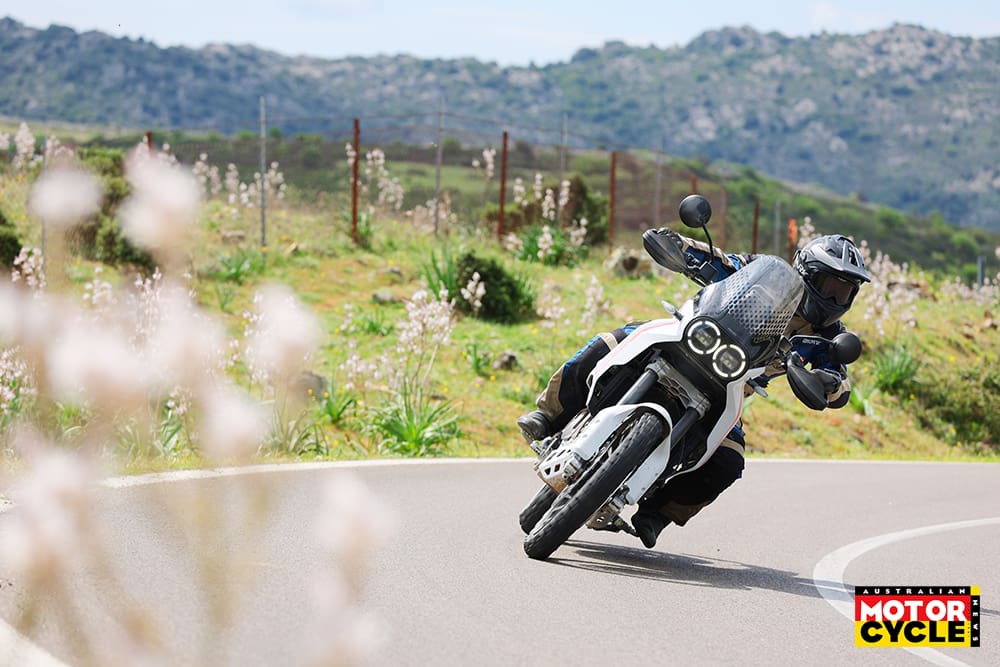
The fully adjustable KYB suspension holds the chassis well, albeit a long way above the ground. Even riding aggressively doesn’t tie it in knots. Yes, there is more travel than ‘normal’ but it’s controlled and has a quality feel to it. The excellent on-road handling for this type of bike is also down to the Pirelli rubber, which gives feedback and stability like a conventional all-round road tyre, despite its appetite for tucking into off-road terrain.
When the 2022 Ducati DesertX hit the first off-road section of our test route I was slightly concerned, simply because the DesertX had performed so well on the road. But once standing on the metal ’pegs (with their rubbers removed), I immediately felt at home among excellent off-road ergonomics, looking over the screen with the dash clearly conveying all the information I needed in a quick glance. It felt natural to stand on the ’pegs, with freedom to move forwards and backwards uninhibited by the tank, seat or bodywork.

The ride quality on the dirt was equally impressive as it was on tarmac. We rode on reasonably rough terrain but there were no complaints from the DesertX. It felt much lighter than its claimed 202kg (dry), and I was able to change my route easily to avoid a large rock or to pop out of a rut, and even able to pop the odd little jump with relative ease. The ’bars didn’t jolt, the fork didn’t bottom out and the rear stayed reasonably composed, even when hitting fairly hard terrain at speed. However, those wanting to ride wide open off-road will need more appropriate rubber.
It’s not an enduro scalpel, of course, but considering the compromises it’s had to make to be able to perform so well on the road, it’s a superbly enjoyable off-road tool too. It’s achieved the best of both worlds which, riding off-road especially, is largely thanks to the electronic technology.

Riding in Enduro mode is like riding with a demon dirt instructor. The off-road ABS is excellent, front and rear, with the rear brake pedal in the perfect position. Only once, braking heavily downhill on loose gravel, did I find the ABS intrusive. The very clever traction control system, meanwhile, will allow the rear to slide, but only up to a point. Even the reduced power of Enduro mode is enough to get the rear Pirelli working overtime, but lean-sensitive traction control takes over and is one of the best systems I’ve experienced. With so much support and reassurance from the electronics I was able to enjoy the ride more; to look up, plot better routes and even admire the stunning scenery.
Rally mode delivers full power, reduced TC, and has ABS only on the front. But again, like Sports mode on the road, this doesn’t turn the DesertX into a beast: the fuelling is still excellent, and the TC still cuts in, but the safety net is a little further away. Experienced riders who really want to ride off road at pace, will be pleased to know both ABS and TC can be fully deactivated should you have the space to make full use of the Ducati’s excellent chassis and full power output. One button turns off the ABS.
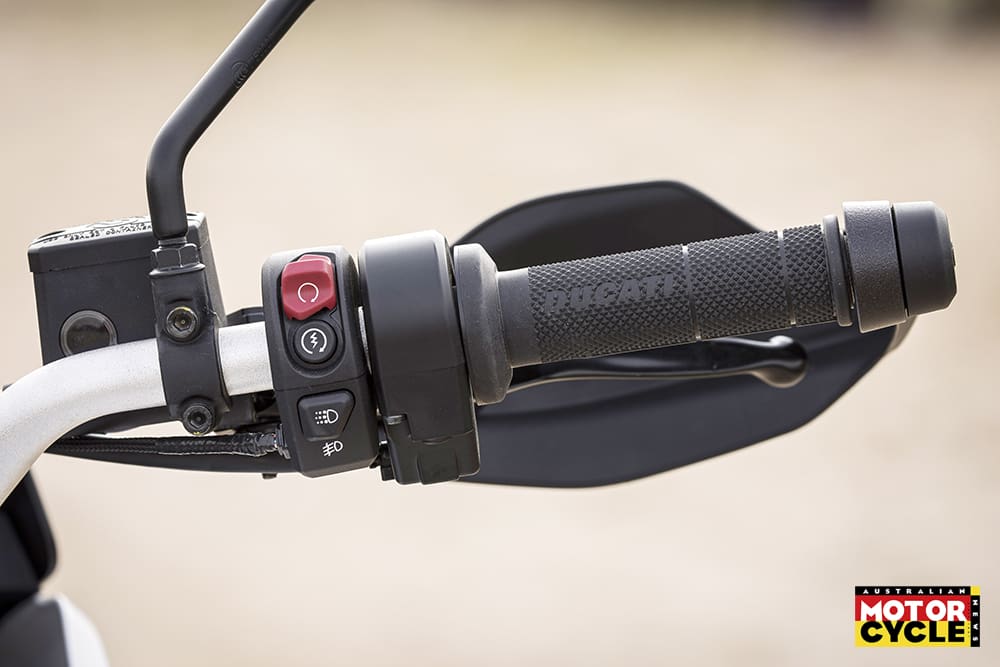
Ducati hasn’t scrimped on the brakes. There are huge M50 callipers up front, similar to the radial stoppers on the Diavel, but with a different master cylinder and discs. The lever is adjustable, as is the height of the brake pedal and the stoppers have a lovely feel both on and off-road.
Cornering ABS comes as standard and there are three modes to choose from: three on the road, two off-road for front and rear brakes, and one off-road for the front only and no rear. You can also disable the ABS entirely. On road the ABS is so good I’m unsure why you’d want to, but some riders may choose to ride without ABS off-road as the settings are very different.
I covered close to 250km in a single day, both off-road (mainly stood up) and on, with no comfort issues. Ducati is claiming a range of 400km from the standard fuel tank, plus another 40 percent if you add the optional eight-litre rear fuel tank. Ride steadily and you could get close to 600 ks before refuelling. Although the rear tank looks cool (and so it should at$1881 plus GST) I think the standard tank’s range will be enough for most. But it’s nice to know you can add the extra fuel tank and cover some serious miles without refuelling. It’s worth noting the pillion hasn’t been forgotten, with a roomy seat position and sturdy grab rail.
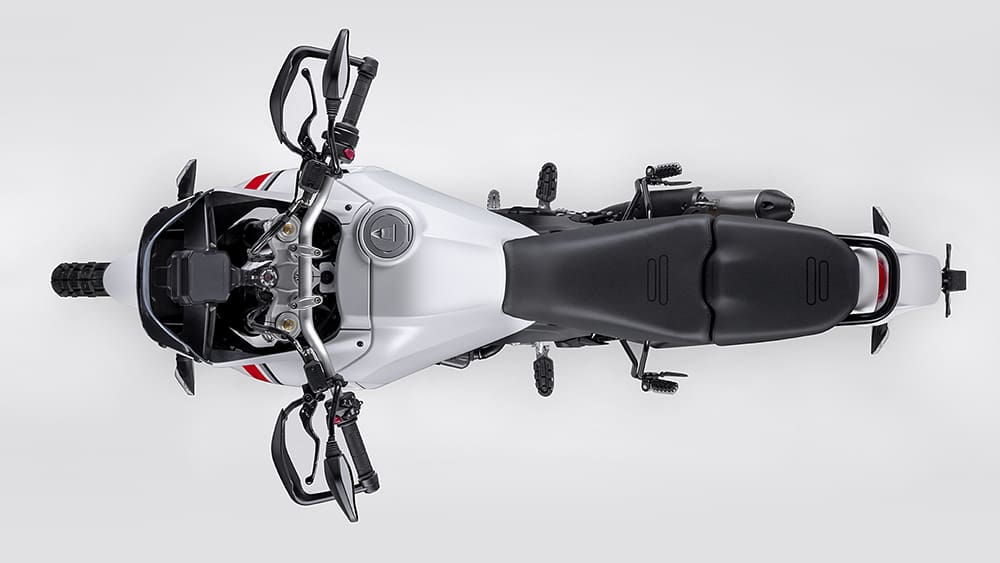
Cruise control comes as standard and, with the rider sitting in the bike and not so much on it, the standard non-adjustable screen did a decent job of deflecting the wind during a short motorway stint. A larger screen is an optional extra along with heated grips.
The five-inch TFT dash is not only clear and easy to read, but also attractive. There are two screen layouts, one for the road and one for off-road. On road features a large digital rev counter and speedo, with a clear gear position. Off-road, the trip, and fuel range become larger. Ducati is also working on an app with Bluetooth connectivity, which will give turn-by-turn navigation on the dash and should be available shortly.
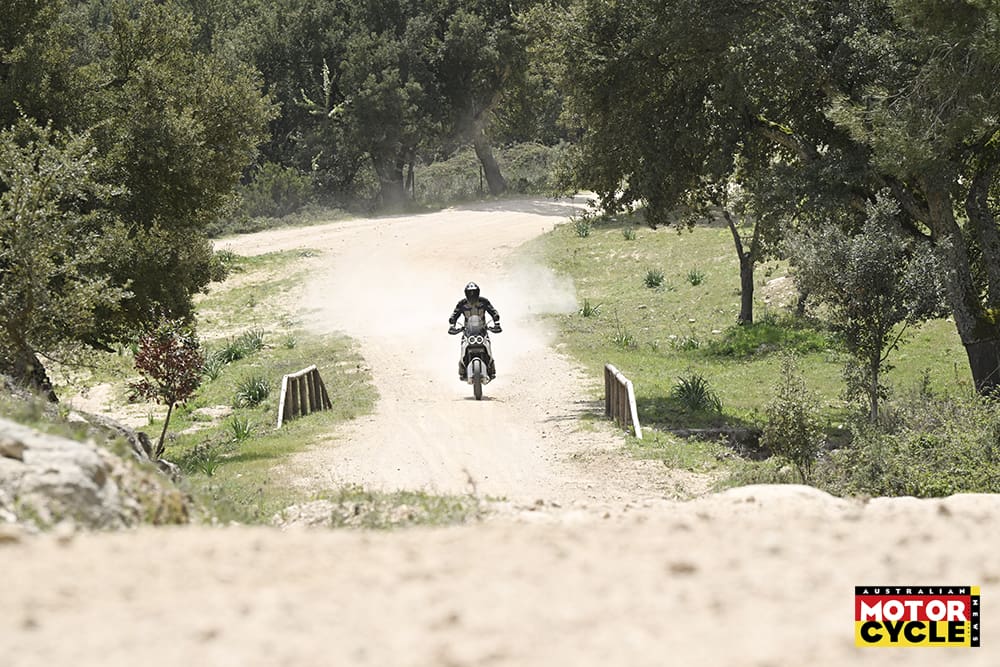
Ducati has entered a new market with its first 21-inch front wheeled bike of the modern era, and they’ve done an excellent job. The looks, retro style and desirability are first class. The engine has enough performance on road, is responsive at low speeds both on and off-road, and is straightforward fun. The chassis is usable, versatile and works both on and off the road, and only extreme off-road riders will find any limitations, mainly the standard rubber. With more off-road focused rubber it would be interesting to see what the Duke could do.
I had so much fun riding both on and off-road, flicking between modes, and enjoying the 2022 Ducati DesertX in its multiple guises, from slowly negotiating small boulders and jumps off-road to having a hoot chasing another X up a mountain pass as speed with big lean and plenty of confidence.

The electronics are easy to use and to personalise and boost riding enjoyment, especially off road, flattering the rider. Many new owners will add accessories packs, be it luggage, extra fuel tank or off-road protection like the sump guard fitted to our test bike. The only question mark is the price; is $24,200 (ride away) asking a little too much? Only time will tell.
2022 Ducati DesertX: Market Equivalents
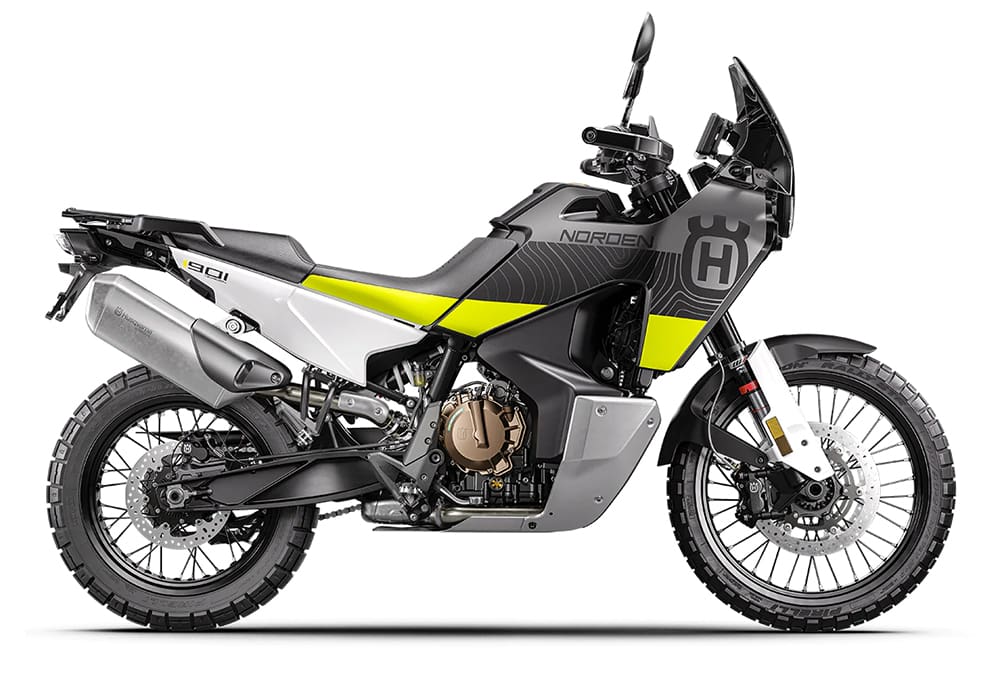
Husqvarna Norden 901 | $25,050 (ride away)

KTM 890 | $25,380 (ride away)

Honda Africa Twin | $20,999 (ride away)